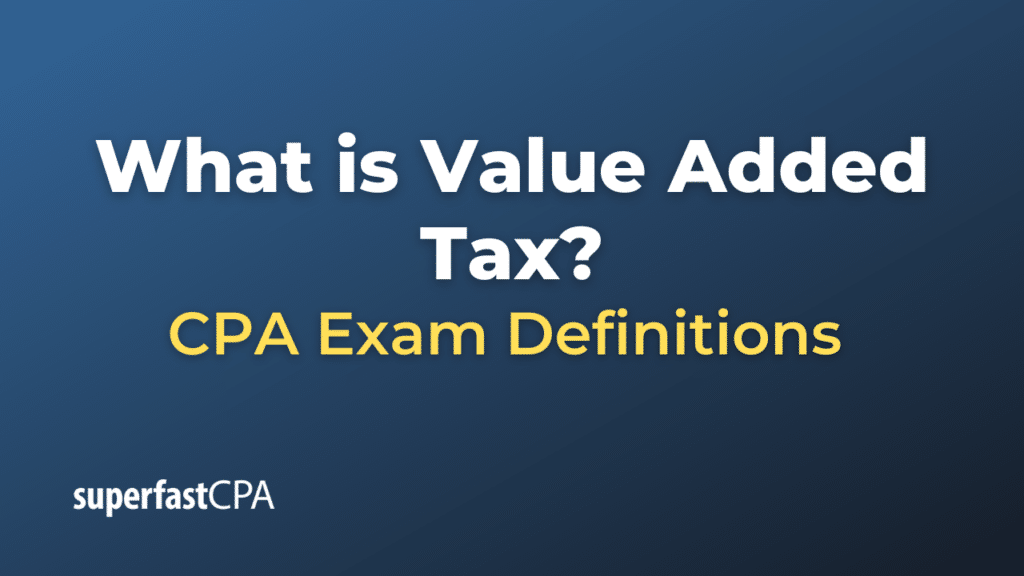Value Added Tax
Value-Added Tax (VAT) is a type of consumption tax levied on the value added to goods and services at each stage of production or distribution. It is a common form of indirect tax used by many countries around the world, particularly in Europe and Asia. The VAT is usually implemented as a percentage of the retail price of goods and services and is paid by the end consumer, although businesses at each stage of the production and distribution process are involved in collecting and remitting the tax.
How VAT Works:
- Production Stages: At each stage in the production of a good or service, the producer pays a VAT on all the materials and services purchased for the business. They then add VAT to the price of the goods they sell, which is paid by the buyer (the next business in the chain).
- Credit Mechanism: Businesses can claim credits for the VAT paid on the materials and services they purchased. This means they remit the difference between the VAT collected from sales to customers and the VAT paid to suppliers to the tax authority.
- End Consumer: The final consumer cannot claim VAT credits and thus bears the full brunt of the VAT charge, making it a consumption tax from the consumer’s point of view.
Importance:
- Revenue Generation: VAT is a significant source of revenue for governments.
- Economic Policy: It can be used as a tool for economic policy, including incentivizing or disincentivizing certain kinds of economic activity.
- Efficiency: Generally considered to be a more efficient form of consumption tax than alternatives like a sales tax.
However, VAT systems can also be complex to administer and can place an administrative burden on businesses required to track and remit the tax.
In summary, Value-Added Tax (VAT) is an indirect tax levied at each stage of production or distribution of goods and services but is ultimately paid by the end consumer.
Example of Value Added Tax
Let’s consider a simplified example that involves a tree farmer, a furniture maker, and a furniture retailer to understand how Value-Added Tax (VAT) works.
Let’s assume a VAT rate of 10% for simplicity.
Stage 1: Tree Farmer to Furniture Maker
- Tree Farmer: Sells wood to the Furniture Maker for $100.
- VAT: 10% of $100 = $10
- Total Cost for Furniture Maker: $100 (wood) + $10 (VAT) = $110
Stage 2: Furniture Maker to Furniture Retailer
- Furniture Maker: Uses the wood to make a table and sells it to the Furniture Retailer for $200.
- VAT: 10% of $200 = $20
- Total Cost for Furniture Retailer: $200 (table) + $20 (VAT) = $220
- VAT Credit for Furniture Maker: $20 (VAT collected) – $10 (VAT paid to Tree Farmer) = $10
The Furniture Maker remits $10 to the government and claims $10 as a VAT credit for the VAT already paid to the Tree Farmer.
Stage 3: Furniture Retailer to End Consumer
- Furniture Retailer: Sells the table to the End Consumer for $300.
- VAT: 10% of $300 = $30
- Total Cost for End Consumer: $300 (table) + $30 (VAT) = $330
- VAT Credit for Furniture Retailer: $30 (VAT collected) – $20 (VAT paid to Furniture Maker) = $10
The Furniture Retailer remits $10 to the government and claims $20 as a VAT credit for the VAT already paid to the Furniture Maker.
Summary:
- Tree Farmer: Collects $10 in VAT and remits $10 to the government.
- Furniture Maker: Collects $20 in VAT but claims $10 in VAT credit for the VAT paid to the Tree Farmer, effectively remitting $10 to the government.
- Furniture Retailer: Collects $30 in VAT but claims $20 in VAT credit for the VAT paid to the Furniture Maker, effectively remitting $10 to the government.
In this example, a total of $30 in VAT is collected at various stages of production and distribution, and the full $30 is paid by the End Consumer. Each business in the supply chain gets to claim credit for the VAT already paid at the earlier stages, thereby avoiding double taxation. The total VAT paid is always borne by the end consumer, making it a consumption tax.
This example simplifies many aspects of how VAT works in practice but provides a basic understanding of the mechanism behind it.













